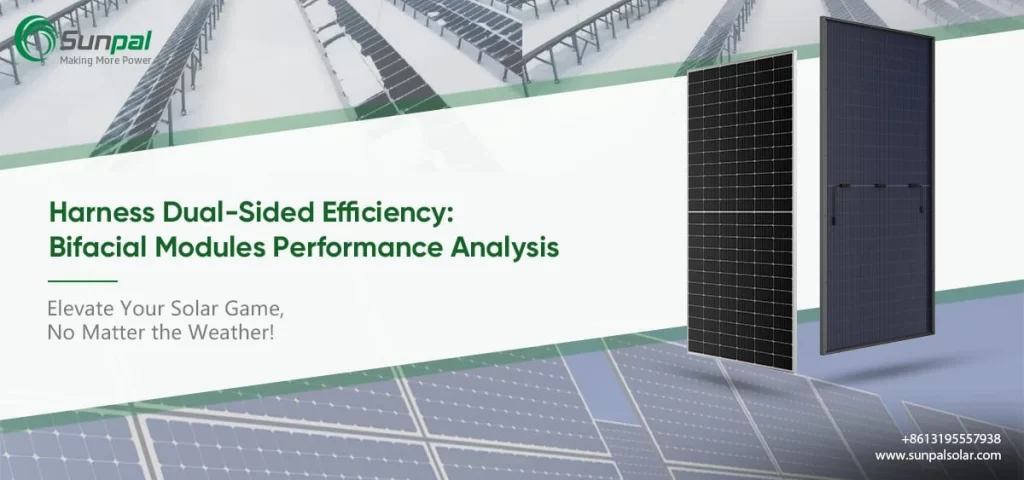
Introduction to Bifacial Solar Modules
Bifacial solar modules have emerged as a game-changing technology in the solar industry. Unlike traditional monofacial panels, bifacial modules can capture sunlight from both sides, potentially increasing energy yield and efficiency. As the demand for more efficient and versatile solar solutions grows, understanding how these modules perform in different climate conditions becomes crucial.
Sunpal Solar, a rising star in the solar panel manufacturing industry, has been at the forefront of bifacial module technology. With their state-of-the-art production lines and commitment to innovation, Sunpal Solar offers high-efficiency bifacial modules tailored for various climatic conditions.
Understanding Bifacial Module Technology
Before diving into the performance analysis, let's briefly explore what makes bifacial modules unique:
- Dual-sided light absorption: Captures sunlight from both front and rear sides
- Increased energy yield: Potential for 5-30% more energy production compared to monofacial panels
- Versatile installation options: Can be used in ground-mounted, rooftop, and vertical installations
- Longevity: Often features dual-glass construction, enhancing durability
Bifacial Modules in Various Climate Conditions: A Comprehensive Analysis
Now, let's examine how bifacial modules perform across different climate zones:
1. Desert Climates: Harnessing Intense Sunlight
In arid regions with high solar irradiance, bifacial modules show exceptional performance:
- Albedo effect: Sand reflects sunlight, boosting rear-side production
- Heat tolerance: Advanced materials maintain efficiency in high temperatures
- Dust mitigation: Smooth glass surfaces facilitate easier cleaning
Performance metrics in desert conditions:

Sunpal Solar's desert-optimized bifacial modules have demonstrated up to 30% higher energy yields compared to traditional panels in these harsh environments.
2. Tropical Climates: Battling Humidity and Diffused Light
In humid, tropical regions, bifacial modules face unique challenges and opportunities:
- Diffused light capture: Excels in capturing scattered light on cloudy days
- Humidity resistance: Advanced encapsulation protects against moisture ingress
- Enhanced cooling: Dual-sided exposure allows for better heat dissipation
Tropical climate performance data:

Sunpal Solar's tropical-ready bifacial modules consistently outperform traditional panels by 10-15% in these challenging conditions.
3. Temperate Climates: Balancing Seasonal Variations
In regions with distinct seasons, bifacial modules offer year-round benefits:
- Snow albedo: Increased winter production due to snow reflection
- Seasonal optimization: Adjustable tilt angles maximize output across seasons
- Moderate temperature performance: Ideal operating conditions in spring and fall
Seasonal performance comparison:

Sunpal Solar's bifacial modules designed for temperate climates show consistent performance advantages throughout the year.
4. Coastal Areas: Combating Corrosion and Harnessing Reflections
Coastal regions present both challenges and opportunities for bifacial modules:
- Salt spray resistance: Special coatings protect against corrosive elements
- Water reflection: Increased energy yield from sunlight reflected off water bodies
- Wind load tolerance: Robust design withstands coastal winds
Coastal performance enhancements:

Sunpal Solar's coastal bifacial modules are designed to thrive in these demanding environments, offering superior longevity and performance.
5. High Altitude Regions: Maximizing Intense UV Exposure
In mountainous or high-altitude areas, bifacial modules capitalize on unique conditions:
- Intense UV radiation: Specialized materials resist UV degradation
- Low temperatures: Increased efficiency in cooler climates
- Reflective surfaces: Snow and ice boost rear-side production
High altitude performance metrics:

Sunpal Solar's high-altitude bifacial modules are optimized to harness these extreme conditions, delivering exceptional performance and longevity.
Factors Influencing Bifacial Module Performance Across Climates
Several key factors affect how bifacial modules perform in different climate conditions:
- Albedo: The reflectivity of the surrounding surface
- Installation angle: Optimal tilt and orientation for bifacial gain
- Row spacing: Affects rear-side shading and overall yield
- Module height: Influences the amount of reflected light captured
- Bifaciality factor: The ratio of rear-to-front-side efficiency
- Climate-specific challenges: Dust, snow, humidity, etc.
Optimizing Bifacial Module Installations for Different Climates
To maximize the performance of bifacial modules across various climate conditions, consider the following strategies:
- Desert installations: Use light-colored ground covers to increase albedo
- Tropical setups: Implement advanced cooling systems and moisture-resistant mounting
- Temperate regions: Adjust tilt seasonally and consider bifacial tracking systems
- Coastal areas: Use corrosion-resistant components and optimize for water reflections
- High altitudes: Focus on UV protection and snow load management
The Future of Bifacial Modules in Diverse Climate Conditions
As technology advances, we can expect:
- Climate-specific optimizations: Modules tailored for unique environmental challenges
- Advanced materials: Improved bifaciality factors and durability
- Smart tracking systems: AI-driven optimization for varying climate conditions
- Integrated weather monitoring: Real-time performance adjustments based on local conditions
Conclusion: The Versatility of Bifacial Modules Across Climates
The performance analysis of bifacial modules in various climate conditions reveals their remarkable adaptability and efficiency. From scorching deserts to humid tropics, temperate zones to coastal regions, and high-altitude areas, bifacial modules demonstrate significant advantages over traditional monofacial panels.
Sunpal Solar's commitment to innovation and quality positions them as a leader in this evolving technology. Their range of climate-optimized bifacial modules offers solutions for diverse environmental challenges, ensuring optimal performance and longevity across the globe.
As the solar industry advances, bifacial modules are set to play an increasingly crucial role in our transition to sustainable energy. Their ability to perform exceptionally well in various climate conditions makes them a versatile and powerful tool in the fight against climate change and pursuing clean, efficient energy production.
By choosing Sunpal Solar's bifacial modules, customers can benefit from cutting-edge technology tailored to their specific climate needs, maximizing energy yield and investment returns. As we look to a future powered by renewable energy, bifacial modules stand out as a shining example of innovation and adaptability in our planet's diverse and challenging climate conditions.
